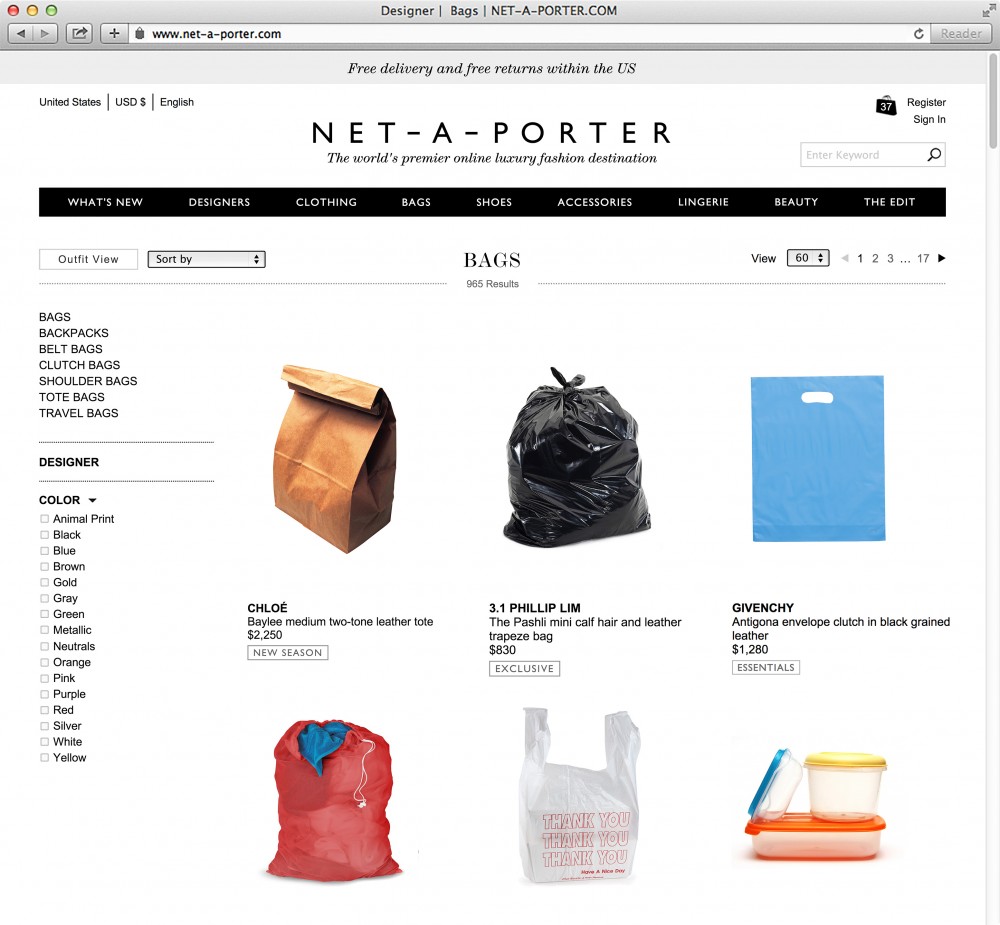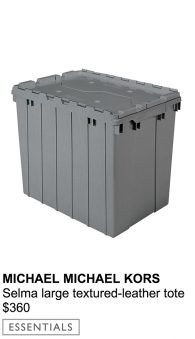“What does the future look like for Internet services, especially those that deliver a product to us with less and less effort on our part?”
Deliverance

It’s about 8:30 on a Friday night. As I walk across town on Houston Street, I see two men in the front cab of a Ford Connect van, sitting in traffic as they yawn. The van is black, and written on the side are the words “Net-A-Porter.com.” These men are transporting high-end fashion to Manhattan’s wealthy clients via Net-A-Porter.com’s Premiere Evening delivery service. For an additional twenty-five dollars, a Fendi bag can show up on your doorstep in a matter of hours.
Founded in 2000 by Natalie Massenet, Net-A-Porter.com is a shopping website that caters to upper-class women who have an appetite for expensive fashions. Massenet was inspired to create Net-A-Porter when she noticed a clear gap in the fashion industry; while reading a fashion magazine, she saw a pair of Chloe jeans she wanted to buy, but when she looked for them online, she couldn’t find a single website selling them. She told Fast Company Magazine in 2010, “I blindly assumed [the retailer] existed because of how brilliantly companies like Amazon were revolutionising service.”1 She set out to fill this void in the fashion industry by creating a website—and as a result, also a business model—that allowed designer pieces to be more readily available online.
Massanet realized early on that the best way to serve a high-end clientele was to present the fashion in a format they were used to: that of a fashion magazine. Items for sale on Net-A-Porter.com are displayed in a magazine-like spread: the images show completed outfits in a collage-like layout, styled by a professional, suggesting to the shopper how they should be worn. The aesthetic of the website looks like a minimalistic magazine, with columns of black text on a plain white background, the only colors being those of the products. The layout of Net-A-Porter.com mirrors that of a fashion magazine; but instead of circling a cute bag with a red pen, you can buy it and have it delivered right to you with only a few clicks.

However, in the fourteen years that have elapsed since the inception of Net-A-Porter, plenty of websites have emerged that carry designer products, presenting them in a layout reminiscent of a fashion magazine. Net-A-Porter is no longer set apart from other shopping sites by its design or by the items that they stock, but rather, by the way in which they use a business model known as vertical integration, a way of streamlining different components of their business. Conventionally, businesses use vertical integration to save money, by doing things such as controlling access to their raw materials or providing direct sale to consumers; for example, a paper company buying land in a forest, or an electronics store selling items directly to customers on their website. However, vertical integration helps Net-A-Porter the most not by saving them money, but by giving the customer an incentive to buy.
While Net-A-Porter does ship items through regular mail services, their most popular method of shipping is same-day delivery, done in vans they own, driven by drivers on their payroll. Because Net-A-Porter owns their means of delivery, they can control where and when their products are sent, and the result of this is quick delivery service. Net-A-Porter knows that a woman is more likely to buy something if it can be on her doorstep by the time she gets home from yoga class. They know that if a woman needs a designer gown for a charity gala tonight, that her only other option is to go into a store and start trying on clothes. The modern wealthy woman is busy, and looks for ways to make her life easier, and Net-A-Porter can provide that for her. Net-A-Porter knows that they are catering to a desire for quick acquisition and instant gratification.
Today, Net-A-Porter is valued at over 350 million British pounds. Their average sale is roughly 500 British pounds, equivalent to over 800 dollars. The top one percent of their clients comprise twenty percent of their sales.2 Their same-day delivery service costs an additional twenty-five dollars, a price some would pay for an item of inexpensive clothing and shipping from another retailer. But what do these numbers say about Net-A-Porter’s clientele, and more importantly what does the culture around this website say about the modern wealthy woman, and the society in which she operates?
The precursor, and yet the antithesis, to the concept of Net-A-Porter is the Hermes Birkin bag. Named after the English actress Jane Birkin, these bags—which cost tens of thousands of dollars—are the status symbol of a woman of privilege. Eonline.com even has a slideshow entitled “celebs with Birkin bags.”3 Aside from being too expensive to be within reach of the average woman, the Birkin bag is virtually inaccessible, because to get one, you need to put your name on a waiting list, and wait—possibly for years—for it to be your turn. These bags show the owner’s status not only by their price tag, but also by showing the lengths they have gone through own one.
Given the lengthy and difficult process of acquiring a Birkin, they become treasures to their owners. Even if you’re wealthy enough to buy multiple Birkins, the supply is far from infinite. The women who own these bags have waited a long time for them, they have not shopped impulsively, and their purchases were not part of their daily routine of surfing the Web. On the other hand, using Net-A-Porter enables you to purchase and receive a bag worth tens of thousands of dollars in less time than it would take to cook a baked ziti. How does this change the value of the bag? Could it be that a beautiful expensive dress, bought impulsively, to be worn that night, would not be as valued in the long run? Would you value something more if you spent hours in the store looking at items, trying them on, and then admiring them in the mirror?

While Net-A-Porter is used mostly by the very rich, it is just one service among hundreds changing how we all acquire goods. The Internet is evolving; and with it, the culture around purchasing the things we want is evolving as well. These services make certain aspects of our daily lives nearly effortless. Seamless Web brings you dinner in a matter of minutes with only a few clicks; it barely feels real. Before Seamless, a person would maybe order a pizza or Chinese food a few times a year, because they did not want to have to call the restaurant or hand over real cash from their wallet. Now, that same person is ordering delivery several times a week without much thought. They click “reorder” and in twenty minutes, there’s a ring at their doorbell. The ease with which this is done dissuades some from actually cooking their own food! Other online merchants are expanding as well. Amazon is looking into drone delivery, and even the odd concept of shipping items to customers before they’ve actually ordered them. The retailers are fueling the consumption.4
What does the future look like for Internet services, especially those that deliver a product to us with less and less effort on our part? If Amazon begins to ship products before we order them, will we end up with piles of junk we probably would’ve removed from our carts—after keeping them there for a few days—having decided we don’t need that new dog coat, or ten pack of iPhone cases? The solution to avoiding this problem seems to be a recognition of the ways in which we are putting ourselves at risk through this behavior. Clicking “reorder” on Seamless every night and having to order enough food to meet the twenty dollar minimum, will not only hurt your wallet, but it will also hurt your health. We need to realize that while these online activities are much easier than physically going to a clothing store or actually cooking your own food, they can become habitual and detrimental. If, as a society, we want to avoid being broke and inundated with more junk than we know what to do with, we simply need to shut off our smartphones and close our laptops.
- http://www.fastcompany.com/1605214/crib-sheet-natalie-massenet-founder-net-porter
- http://www.theguardian.com/lifeandstyle/2010/jul/11/natalie-massenet-net-a-porter-internet-fashion
- http://www.eonline.com/photos/6561/celebs-with-birkin-bags
- http://www.cnn.com/2013/12/02/tech/innovation/amazon-drones-questions/